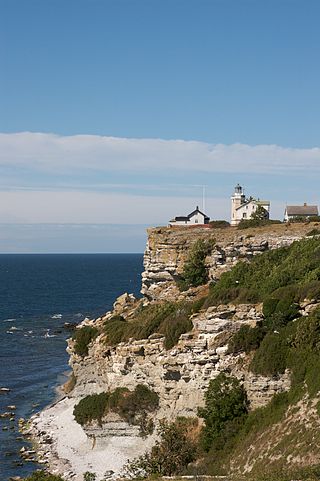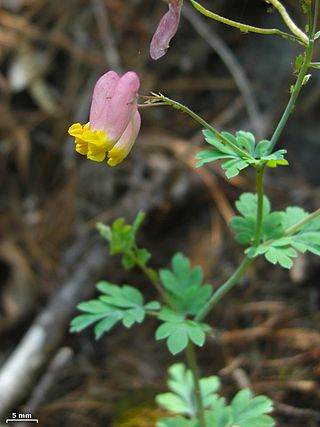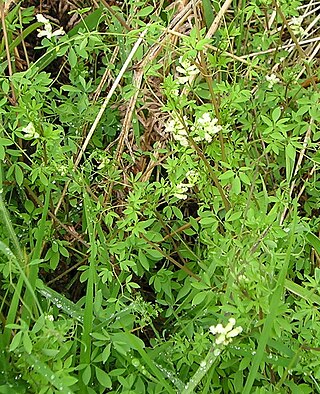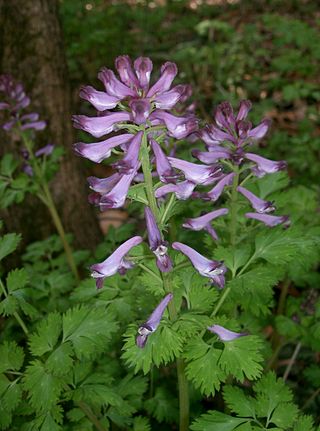
Fumarioideae is a subfamily of the family Papaveraceae. It was formerly treated as a separate family, the Fumariaceae. It consists of about 575 species of herbaceous plants in 20 genera, native to the Northern Hemisphere and South Africa. The largest genus is Corydalis.

Stora Karlsö is an island off the west coast of Gotland, Sweden; part of Eksta socken. It is mostly known for its rich birdlife with large colonies of common guillemot, and flora. Stora Karlsö is a nature reserve, the second oldest in the world after Yellowstone National Park.

The Papaveraceae are an economically important family of about 42 genera and approximately 775 known species of flowering plants in the order Ranunculales, informally known as the poppy family. The family is cosmopolitan, occurring in temperate and subtropical climates like Eastern Asia as well as California in North America. It is almost unknown in the tropics. A common flower in this family includes Papaver somniferum that's used for the generation of opium as its also called the opium poppy. This family is also rich in alkaloids allowing it to be used in medicine. C. majus is a flower in this family which has antiviral effects against influenza and antiviral, antitumor and antifungal effects all due to it alkaloid properties. Most are herbaceous plants, but a few are shrubs and small trees. The family currently includes two groups that have been considered to be separate families: Fumariaceae and Pteridophyllaceae. Papaver is the classical name for poppy in Latin.

Corydalis is a genus of about 540 species of annual and perennial herbaceous plants in the family Papaveraceae, native to the temperate Northern Hemisphere and the high mountains of tropical eastern Africa. They are most diverse in China and the Himalayas, with at least 357 species in China.

Bulbocapnine is an alkaloid found in Corydalis and Dicentra, genera of the plant family Fumariaceae which have caused the fatal poisoning of sheep and cattle. It has been shown to act as an acetylcholinesterase inhibitor, and inhibits biosynthesis of dopamine via inhibition of the enzyme tyrosine hydroxylase. Like apomorphine, it is reported to be an inhibitor of amyloid beta protein (Aβ) fiber formation, whose presence is a hallmark of Alzheimer's disease (AD). Bulbocapnine is thus a potential therapeutic under the amyloid hypothesis. According to the Dorlands Medical Dictionary, it "inhibits the reflex and motor activities of striated muscle. It has been used in the treatment of muscular tremors and vestibular nystagmus".

Corydalis flavula is an herbaceous perennial plant native to the eastern United States. Its natural habitat is open woods and slopes.

Capnoides sempervirens, the harlequin corydalis, rock harlequin, pale corydalis or pink corydalis, is an annual or biennial plant native to rocky woodland and burned or disturbed places in northern North America. Capnoides sempervirens is the only species in the genus Capnoides.

Parnassius autocrator is a species of butterfly in the family Papilionidae. It is found in Afghanistan and Tajikistan. Parnassius autocrator is a high-altitude butterfly. The preferred larval food plant is Corydalis adiantifolia.

The Circumboreal Region in phytogeography is a floristic region within the Holarctic Kingdom in Eurasia and North America, as delineated by such geobotanists as Josias Braun-Blanquet and Armen Takhtajan.

Corydalis ambigua is a tuberous early flowering east Asian flowering plant species in the poppy family Papaveraceae. Its exact native range is obscure due to taxonomic confusion. It is one of the sources of the drug tetrahydropalmatine.

Corydalis solida, fumewort or bird-in-a-bush, is a species of flowering plant in the family Papaveraceae, native to moist, shady habitats in northern Europe and Asia. Growing to 25 cm (10 in), it is a spring ephemeral, with foliage that appears in spring and dies down to its tuberous rootstock in summer. It is cultivated for its deeply divided, ferny leaves and narrow, long-spurred flowers which appear in spring. The flowers show color variation, and may be mauve, purple, red, or white.

Pseudofumaria is a genus of herbaceous perennial plants native to Europe, formerly included in the genus Corydalis.

Nantenine is an alkaloid found in the plant Nandina domestica as well as some Corydalis species. It is an antagonist of both the α1-adrenergic receptor and the serotonin 5-HT2A receptor, and blocks both the behavioral and physiological effects of MDMA in animals.

Ceratocapnos claviculata, the climbing corydalis, is a weak scrambling plant in the family Papaveraceae. It is endemic to Europe, growing mostly near the Atlantic fringe.

Corydalis nobilis, the Siberian corydalis, is a perennial plant native to Siberia, Xinjiang and Kazakhstan. It was introduced to Europe by Linnaeus, who had asked his friend Erich Laxmann for seeds of Lamprocapnos spectabilis, but was sent seeds of C. nobilis instead. Both Lamprocampnos and Corydalis are members of the family Papaveraceae, with seeds having an attached elaiosome that makes them attractive to ants, which disperse the seeds.

The Nera Gorge-Beușnița National Park is a protected area situated in Romania, in Caraș-Severin County.
Corydalis yanhusuo is a plant species in the genus Corydalis. The Chinese name for Corydalis yanhusuo is yan hu suo. The Japanese common name is engosaku (エンゴサク) and the Korean common name is hyeonhosaek (현호색). English common names include yanhusuo, corydalis, and Asian corydalis. The tuber of this plant, frequently mislabeled as the root, is an important therapeutic agent in traditional Chinese medicine. It is native to high-altitude grasslands across China including in the provinces of Anhui, Henan, Hubei, Hunan, Jiangsu, and Zhejiang, but is more widely cultivated.
Corydalis filistipes is a perennial flowering plant in the family Papaveraceae. It is found only on Ulleung Island in North Gyeongsang Province, South Korea. It is listed as vulnerable on the IUCN Red List of Threatened Species.

Corydalis incisa, incised fumewort, is an annual or biennial herbaceous species of plant in the poppy family. It is also known as purple keman or murasa-kike-man. Some authorities report it in the family Fumariaceae. The wildflower is native to Japan, Korea, Taiwan, and China, found in forests, clearings, and irrigation channels.

Corydalis cava is a species of flowering plant in the family Papaveraceae, native to moist, shady, woodland habitats throughout most of mainland Europe, although commonest in central and southeast Europe. Its range extends from Spain in the west to Ukraine, Belarus and the Caucasus in the east and as far north as Sweden. It is absent from Iceland, the UK, the Netherlands, Norway, Finland, Russia and Greece.


















